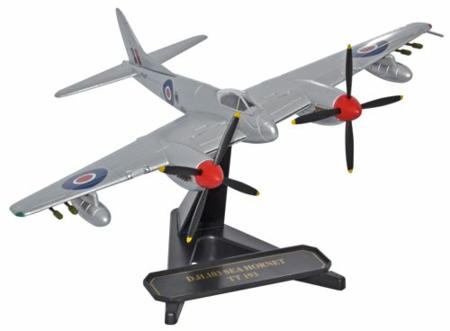de Havilland Sea Hornet F20 – TT193, Royal Navy Fleet Air Arm
Add to compare1 in stock
£25.00 £34.99
1 in stock
Oxford 72HOR002 1/72 scale de Havilland DH.103 Sea Hornet F20 TT193 of the Royal Navy Fleet Air Arm. History of flight Range in De-Luxe Box with optional undercarriage positions, rotating propellers and quality display stand in a smart presentation box.
Length 6.25 inches Wingspan 7.5 inches.
The de Havilland DH.103 Hornet was a piston engine fighter that further exploited the wooden construction techniques pioneered by de Havilland’s classic Mosquito. Entering service at the end of the Second World War, the Hornet equipped postwar RAF Fighter Command day fighter units in the UK and was later used successfully as a strike fighter in Malaya. The Sea Hornet was a carrier-capable version.
The prototype Hornet achieved 485 mph (780 km/h) in level flight, which came down to 472 mph (760 km/h) in production aircraft.
The Hornet entered service in 1946 with 64 Squadron based at RAF Horsham St Faith. Next to convert to the Hornet was 19 Squadron at RAF Wittering, followed by 41 Squadron and 65 Squadron, both based at RAF Church Fenton. No. 65 Sqn was to participate in one of the first official overseas visits by an RAF unit when they visited Sweden in May 1948. Pilot conversion to the Hornet was provided by No. 226 Operational Conversion Unit (O.C.U.) which was based at RAF Molesworth.
During their relatively short operational service Hornets participated in several record attempts and air races; for example, on 15 September 1949 Flight Lieutenant H. Peebles flew from RAF Bovingdon to Gibraltar at an average speed of 357.565 mph (574.445 km/h), setting a new British point-to-point record, only to see it broken three days later when Group Captain A.P.C. Carver flew back to Bovingdon, averaging 435.871 mph (701.466 km/h).
Operationally, the Hornet I (later F 1) was to last only a short time before being superseded by the F 3 version. The first Hornet F 3 was PX 366 which flew at the Farnborough Air Show in June 1946.
New units to convert to this mark were 33 Squadron, 45 Squadron (based at RAF Tengah, Singapore where, in early 1952, the unit converted to the Hornet from the unreliable Bristol Brigand) and 80 Squadron. Along with 64 Sqn these squadrons operated in Malaysia where they replaced Beaufighters and Spitfires operating against Communist guerrillas during the Malayan Emergency. Armed with rockets and/or 1,000 lb (454 kg) bombs Hornets, with their long range and good endurance, were able to spend up to two hours loitering over the target area. They also proved to be very reliable; 45 Sqn Hornets, based in Singapore achieved 4,500 operational sorties over five years. The last operational Hornet sortie was flown on 21 May 1955.
On 23 July 1954, two Hornets from RAF Kai Tak in Hong Kong were the first to arrive on the scene of a shootdown of a Cathay Pacific Skymaster off the coast of Hainan Island. All Hornets were withdrawn from operational service by mid-1956.
The Sea Hornet F 20 was the appropriately named Naval version. The only Naval unit fully equipped was 801 Squadron on 1 June 1947 at RNAS Ford. After a move to Arbroath the squadron embarked on HMS Implacable. In 1951, another move was made to HMS Indomitable until, in June, the Sea Hornets were replaced by Hawker Sea Furies.
Other Sea Hornets were attached to various Naval Squadrons, including three which were attached to 806 Squadron which, along with a Vampire and two Sea Furies, were embarked on HMCS Magnificent for a tour of North America in 1948. The Sea Hornets gave several spectacular flying displays at the International Air Exposition in New York between 31 July and 8 August. In mid-1948, one Sea Hornet, PX219, was adapted to carry 2 × Highballs in an installation that was developed but not applied to the fleet. The equipment was removed during January 1949 and it is currently unknown if the Hornet ever dropped a Highball during flight.
In January 1949, the Sea Hornet NF 21-equipped 809 Squadron at RNAS Culdrose, moved to HMS Illustrious and then, in May 1951, to HMS Vengeance. The unit was then briefly seconded to the RAF at Coltishall before a posting to Hal Far Malta where it disbanded in 1954. The NF.21 later equipped the Fleet Requirements Units at Hal Far, Malta, and St Davids, West Wales.
| Weight | 0.9 kg |
|---|

